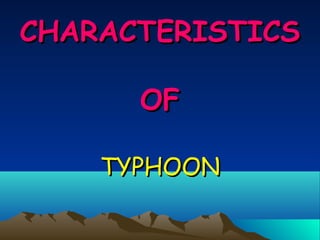
Typhoon
- 4. WWhhaatt iiss TTyypphhoooonn • Tropical cyclone is a rapidly rotating storm system characterized by a low-pressure center, strong winds, and a spiral arrangement of thunderstorms that produce heavy rain. Depending on its location and strength, a tropical cyclone is referred to by names such as hurricane , tropical storm, cyclonic storm, tropical depression, and simply cyclone. • A typhoon refers to a strong tropical cyclone in a particular region. The same storm may be considered a typhoon in one region of the ocean and a hurricane in another region. Typhoons can cause serious damage to unsuspecting travelers or homeowners, so it is important to understand the characteristics of these storms.
- 5. PPHHYYSSIICCAALL SSTTRRUUCCTTUURREE • Tropical cyclones are areas of relatively low pressure in the troposphere, with the largest pressure perturbations occurring at low altitudes near the surface. On Earth, the pressures recorded at the centres of tropical cyclones are among the lowest ever observed at sea level.[3] The environment near the center of tropical cyclones is warmer than the surroundings at all altitudes, thus they are characterized as "warm core" systems.
- 6. Wind field • The near-surface wind field of a tropical cyclone is characterised by air rotating rapidly around a centre of circulation while also flowing radially inwards. At the outer edge of the storm, air may be nearly calm; however, due to the Earth's rotation, the air has non-zero angular momentum. As air flows radially inward, it begins to rotate cyclonically (counter-clockwise in the Northern Hemisphere, and clockwise in the Southern Hemisphere) in order to conserve angular momentum. At an inner radius, air begins to ascend to the top of the troposphere. This radius is typically coincident with the inner radius of the eyewall, and has the strongest near-surface winds of the storm; consequently, it is known as the radius of maximum winds.[5] Once aloft, air flows away from the storm's center, producing a shield of cirrus clouds.[6] • The previously mentioned processes result in a wind field that is nearly axisymmetric: Wind speeds are low at the centre, increase rapidly moving outwards to the radius of maximum winds, and then decay more gradually with radius to large radii. However, the wind field often exhibits additional spatial and temporal variability due to the effects of localized processes, such as thunderstorm activity and horizontal flow instabilities. In the vertical direction, winds are strongest near the surface and decay with height within the troposphere.[7]
- 7. • Eye and center At the center of a mature tropical cyclone, air sinks rather than rises. For a sufficiently strong storm, air may sink over a layer deep enough to suppress cloud formation, thereby creating a clear "eye". Weather in the eye is normally calm and free of clouds, although the sea may be extremely violent.[8] The eye is normally circular in shape, and is typically 30–65 km (19–40 mi) in diameter, though eyes as small as 3 km (1.9 mi) and as large as 370 km (230 mi) have been observed.[9][10] • The cloudy outer edge of the eye is called the "eyewall". The eyewall typically expands outward with height, resembling an arena football stadium; this phenomenon is sometimes referred to as the stadium effect.[11] The eyewall is where the greatest wind speeds are found, air rises most rapidly, clouds reach to their highest altitude, and precipitation is the heaviest. The heaviest wind damage occurs where a tropical cyclone's eyewall passes over land.[8] • In a weaker storm, the eye may be obscured by the central dense overcast, which is the upper-level cirrus shield that is associated with a concentrated area of strong thunderstorm activity near the center of a tropical cyclone.[12] • The eyewall may vary over time in the form of eyewall replacement cycles, particularly in intense tropical cyclones. Outer rainbands can organize into an outer ring of thunderstorms that slowly moves inward, which is believed to rob the primary eyewall of moisture and angular momentum. When the primary eyewall weakens, the tropical cyclone weakens temporarily. The outer eyewall eventually replaces the primary one at the end of the cycle, at which time the storm may return to its original intensity.[13] • I
- 8. •
- 9. TTyypphhoooonn SSttoorrmm SSccaallee • A typhoon refers to a tropical cyclone that takes place in the northwest Pacific Ocean, west of the international date line. A tropical cyclone is defined as a non-frontal synoptic scale low pressure system that occurs over either tropical or sub-tropical waters. This scale occurs either with organized convection or with definite cyclonic types of wind circulation. • The date line is on the 180 degrees line of longitude in the middle of the Pacific Ocean. Almost 90 percent of typhoons originate from the Federated States of Micronesia or Chuuk part of the Pacific Ocean. When a storm travels east in the Pacific Ocean past the date line, it is reclassified as a typhoon
- 10. TTyypphhoooonn SSeeaassoonnss The typhoon season is not limited to certain months, as the hurricane season usually is. A typhoon may occur during any month of the calendar year, although the storms tend to peak between May and November. However, the typhoons that originate in the Federated States or Chuuk part of the Pacific tend to peak between August and October. This peak season correlates with the Atlantic hurricane seasons
- 11. TTyypphhoooonn PPaatthhss You can analyze typhoons by the different directions they travel. A typhoon usually follows three different directions: straight, recurving and northward. A straight path is defined as a westward path; the storm will head toward the Philippines, the south of China, Taiwan and Vietnam. A storm that follows a recurving path will head towards the east of China, Taiwan, Korea and Japan. A northward path occurs when the storm simply heads north of its point of origin. This will affect small islands throughout the Pacific Ocean.
- 12. TTHHAANNKKSS